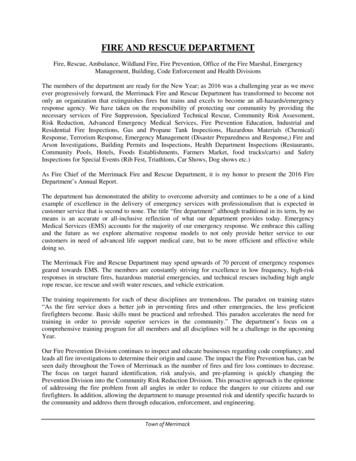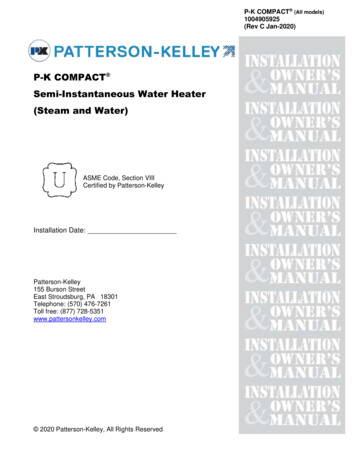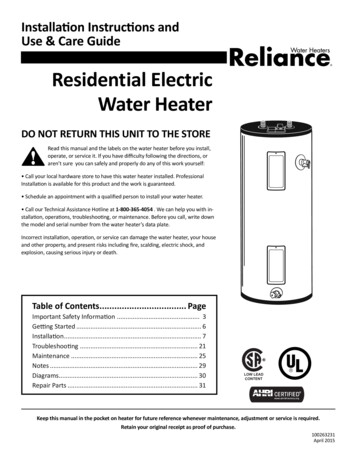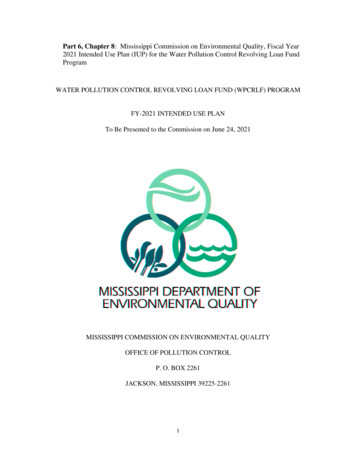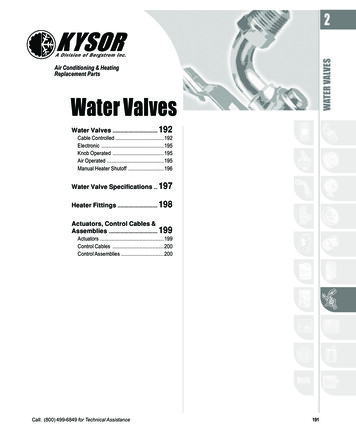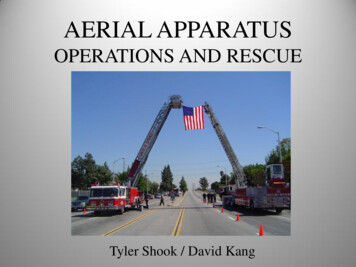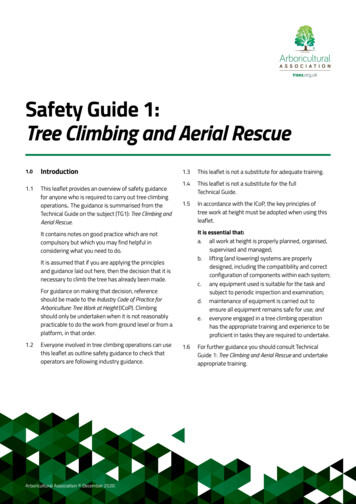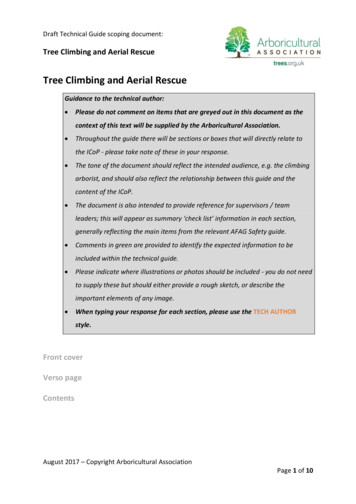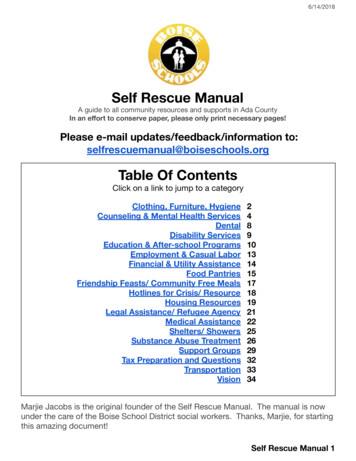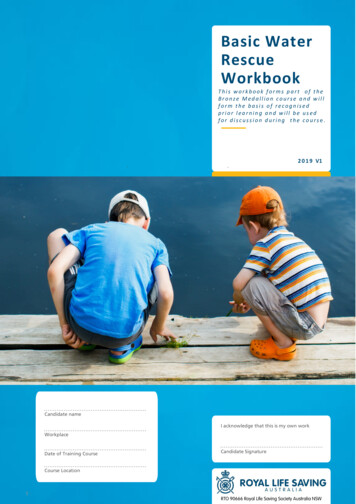
Transcription
Basic WaterRescueWorkbookThis workbook forms part of theBronze Medallion course and willform the basis of recognisedprior learning and will be usedfor discussion during the course.2 0 1 9 V1Candidate nameI acknowledge that this is my own workWorkplaceDate of Training CourseCandidate SignatureCourse Location1RTO 90666 Royal Life Saving Society Australia NSW
SISCAQU002 Perform basic water rescuePerformance EvidenceEvidence of the ability to complete tasks outlined in elements and performance criteria of this unit in thecontext of the job role, and: identify, evaluate and respond to aquatic emergencies according to organisational and legislativerequirementsidentify and respond to all of the following signs and signals:-call for help-vertical body position-minimal or non-supportive leg action-vigorous arm movements-submerged or unconscious personperform the following non-swimming rescues:-reach-rope throw-throw flotation aidperform the following swimming rescues demonstrating the fitness and strength to tow a person indifficulty at least 10 metres with their mouth and nose above water to a point of safety:-accompanied-wade-non-contact tow-contact towincorporate appropriate adjustments for each of the above rescues to ensure safety of self andothers.Knowledge EvidenceDemonstrated knowledge required to complete the tasks outlined in elements and performance criteria ofthis unit: legislation, organisational policies and procedures and industry standards in relation to:-the safe conduct of water rescues-accurate completion of incident documentationcommon signs and signals of a person experiencing difficulties in the water and possiblecontributing factors:-call for help-vertical body position-minimal or non-supportive leg action-vigorous arm movements-submerged or unconscious personuse and location of equipment typesnon-swimming rescue methods and techniques:-reach-rope throw-throw flotation aidswimming rescue methods and techniques:-accompanied-wade-non-contact tow-contact towissues that arise during rescues and appropriate adjustments to ensure safety of self and otherscommunication systems used during rescues to inform managers, other employees and emergencyservices of progresspotential dangers in a range of aquatic environments and how to respond2
Module 1: Water Safety1. List 3 potential dangers in each of the following aquatic environments.(Page 23-31)LocationDangersRiversLakes and damsFarmsBeach/oceanSwimming PoolAround the homeFloods3
2. There are 3 types of Lifejackets. Identify the features and intended uses of each.(Page 36)LifejacketFeaturesIntended useLevel 100Level 50Level 50-S4
Module 2: Survival Sequence3. Describe when and how to perform the following entries. (Page 44-48)Entry TypeWhenHowWade inSlide inStep inCompactjumpDive entryStride entryAccidentalfall in5
4. When should survival sculling be used? (Page 51)5. When is the eggbeater kick useful? (Page 55)6. What are the two methods of maintaining body temperature when the body isexposed to cold water? Briefly explain the advantages and disadvantages of the twotechniques. (Page 64)MethodAdvantagesDisadvantages1.2.6
Module 3: Swimming and Lifesaving Strokes7. List the 6 main swimming strokes. (page 68)Module 4: Lifesaving Skills8. List the 4 rescue principles and provide a summary of each. (Page 84)Rescue principleExplanationAAAA9. List 5 signs of someone who is experiencing difficulty in the water (Page 86-87)7
10. Circle the correct type of swimmer and list 3 implications for the rescuer. (Page 8687)Type of swimmerImplications for the rescuer1.a) Non Swimmerb) WeakSwimmer2.c) InjuredSwimmerd) Unconscious3.1.a) Non Swimmerb) WeakSwimmer2.c) InjuredSwimmerd) Unconscious3.1.a) Non Swimmerb) WeakSwimmer2.c) InjuredSwimmerd) Unconscious3.1.a) Non Swimmerb) WeakSwimmer2.c) InjuredSwimmerd) Unconscious3.8
Module 5: Rescue Techniques11. List when and how the following rescue techniques should be utilised. (Page w12. Describe when the following techniques would be used. (Page ng9
13. List when and how the following swim rescues should be utilised. (Page 106-107)Swim RescueWhenHowAccompaniedrescueNon-contacttow14. List when and how the following contact tows should be utilised. (Page 110-111)TowWhenHowCross chesttowHead towDouble armpittow10
Doubleshoulder tow15. List when the following spinal management techniques should be utilised. (Page 119121)Type of spinal rollWhenHowVice grip rolloverExtended armrollover11
16. Answer the questions below on the following scenario:You are at a river bank where you have observed 3 swimmers (a male adult, a teenagefemale, and a young male) happily swimming in the river. You notice that they are quite far fromthe riverbank, and they are not wearing lifejackets, so you decide to keep an eye out. Severalhundred metres away is the river’s boat ramp, which is getting very busy with boats being loadedonto the river, and setting off along the water.A short time later, a current begins to flow along the river, and you observe the 3 swimmerssuddenly start to experience difficulty in the water, which has become disturbed by the current. All3 swimmers are not wearing lifejackets, and appear to be distressed and fatigued as they signal forhelp, approximately 50m from the edge of the river. All 3 swimmers display a vertical position, withvigorous arm movements, and very minimal leg action, as they struggle to stay afloat.The water is accessible from the river bank, which appears to have a 30cm drop to the water level.The water is murky in appearance, and you are unsure of the depth at the river’s edge. Among ariverbank of scattered bystanders, you quickly alert 2 adults (one male and one female), who areunpacking equipment from their vehicle in the nearby carpark; among the equipment are 2lifejackets, a canoe oar, and a small esky lid. The female states that she is a strong swimmer, and isconfident to enter the water; the male is more hesitant, but says he will coordinate what needs tobe done from land. As you start to relay instructions to the 2 bystanders to coordinate the rescue, adistressed middle aged woman identifies herself as the mother of the children, and hystericallypleads with you to save her children and her husband.a) Based on your knowledge of the 4 categories assigned to swimmers experiencingdifficulty, how would you categorise the swimmers who are experiencingdifficulty? Why?b) What are the immediate dangers to yourself, and other rescuers that need to beconsidered before attempting to carry out a rescue?12
c) Detail the instructions you would give to the other bystanders who have offeredtheir assistance in carrying out the rescue, as well as the role you would assumefor yourself. (Remember: while only one of them was confident about entering thewater, the other was happy to coordinate some tasks on land)d) Outline the tasks that the land-based bystander could conduct before, during, andafter the aquatic rescue sequence takes place.e) Complete the incident report form (over the page) based on yourresponse to the scenario.13
Incident Report FormStaff Member Reporting IncidentName:Date:Position:Signature:Person(s) involved in the incidentGiven Name/s:Surname:Gender:Male/ FemaleDate of birth:Address:Suburb:Postcode:Telephone number:Parent/Guardian of casualty’s details: (If Applicable)Given Name/s:Surname:Gender:Male/ FemaleDate of birth:Address (if different to person involved in accident/incident):Suburb:Postcode:Telephone number:About the accident/incidentType:Minor/ MajorDate:Time:Where did the injury take place?Accident/Incident DescriptionInjury LocationRTO 90666 Royal Life Saving Society Australia NSW14
Treatment Required:Emergency ServicesWere Emergency Services required to deal with the incident?Type:AmbulancePoliceTime requested:FireTime of Arrival:Officer/s Name:Other rOther:Witness Details (if phone:RefusalI understand that I have been offered specific first aid treatment by staff and I refusethat treatment.Signature:If under 18yrs Parent or Guardian:Post Accident/ Incident Follow upAccident/Incident area checked for risk:YesNoOutcome:Shift supervisorDate:Signature:15RTO 90666 Royal Life Saving Society Australia NSW
Answer the questions below on the following scenario: You are at a river bank where you have observed 3 swimmers (a male adult, a teenage female, and a young male) happily swimming in the river. You notice that they are quite far from the riverbank, and they are not wearing lifejackets, so you decide to keep an eye out. Several . hundred metres away is the river’s boat ramp, which is getting .
